|
We are in:
|
|
Kini & Kimi Go
Down-Under to Australia
With Bob & Amy
|
We are in:
|
|
| Introduction: | The beginning of a new adventure |
| June 17 - 22, 2001: | The Coral Tree Inn / Scuba Diving |
| June 23 - 24, 2001: | Tjapukai Aboriginal Cultural Park / Skyrail / Train || The City of Cairns |
| June 25, 2001: | Headed Toward the Bush / Split Rock / Termite Mounds || The Homestead / Jowalbinna Bush Camp |
| June 26, 2001: | The Track / 3 Deaf Adders & Flying Foxes Galleries || Honeymoon & Garfish Galeries || The Red Lady Gallery || The Tent Shelter Gallery || Billy Boils at the Billabong || After Lunch & Our Second Hike |
| June 27, 2001: | On the Way and Into Cooktown || The Black Mountains || The Mungumby Lodge |
| June 28 - 30, 2001: | The Treck Home || Winding It Up.... || Coming Home |
The world is about 24,000 miles around. We traveled 12,000 miles of them to get to Australia. Bob says that we spent about 21 hours just in the airplanes. With Bob's help, Kini figured out that if he divided the number of miles we traveled by the number of hours we traveled, we would find out the miles per hour the airplanes were traveling. It took some figuring, but we found out that the airplane was flying at about 571 miles per hour! We were glad that the windows couldn't open! We were on our way to spending two weeks "Down-Under"!
Our plane took us from Roanoke, Virginia to Charlotte, North Carolina, then on to Los Angeles (LA), California. Then we hopped on a plane that took us to Sydney, Australia and finally to the city of Cairns which would be our base of operations for the trip. By the way, Cairns is pronounced like the word "cans".
On the flight from LA to Sydney a bunch of great things happened. First, we crossed from the northern hemisphere into the southern hemisphere when we flew over the equator. Did you know that when water spins down a drain in the northern hemisphere, it moves the counter-clockwise? And, when it goes down the drain in the southern hemisphere, it moves clockwise. This is a result of the Coriolis Effect, or the spin of the Earth. That is also the reason that cyclones spin in different directions depending on whether or not they are above or below the equator.
Second, we crossed the international date line which meant that we lost 24 hours. That is like losing a whole day! But then, we get to add 24 hours on the way home. And finally, the last interesting thing that happened on the airplane ride was that it was 14 hours long with no stops! That was a very long time to sit in an airplane seat and a real long time for an airplane to fly non-stop!
Kimi, Amy, and I wanted to thank Bob for his planning and phone calls, and Gail Troxel of Oz Dive (http://www.ozdive.com) for her wonderful help and friendly service in setting up this trip. You will meet all the other people that made this trip so wonderful as you surf through Kini and Kimi's Australian adventure page. Yahoo! Let the adventure begin...!
The Coral Tree Inn / Scuba Diving
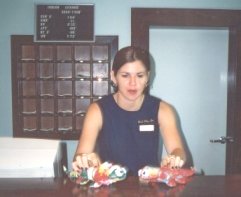 When we checked into the
Coral Tree Inn, Trudi met us at the front desk.
She was so much fun! She had a smile waiting for us every day, even if it was 6 o'clock in
the morning! Trudi was a big help to us and she was fun to joke with. One time we even got
her to blush! She said we were "cheeky" - we liked that!
When we checked into the
Coral Tree Inn, Trudi met us at the front desk.
She was so much fun! She had a smile waiting for us every day, even if it was 6 o'clock in
the morning! Trudi was a big help to us and she was fun to joke with. One time we even got
her to blush! She said we were "cheeky" - we liked that!
Bob and Amy's first adventure in Australia was when they left Cairns to go scuba diving on the Great Barrier Reef on a live-a-board boat where they would dive & live for four days. Everyone aboard had a great time and even spent one whole day scuba diving and snorkeling with 10 to 15 Minke whales! These whales are filter-feeders, about 30 feet long, very curious creatures, and would swim within 2 or 3 feet of us!
When we came back we had a couple of days to play in Cairns.
Tjapukai Aboriginal Cultural Park / Skyrail / Train
The first adventure we all had together was when we climbed on a bus to go to the Tjapukai Aboriginal Cultural Park. We saw some of the traditional dances, learned about how the aboriginal people believe the world was created, and got to meet some wonderful people. Take a look at some of the pictures we took.
|
|
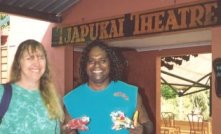 |
 |
|
|
|
|
It is a bit hard to see us, but Kimi and I got to meet two of the dancers and have our picture taken with them! |
|
 |
After the park, we rode the Skyrail up to the town of Kuranda. That was exciting! It took 1 1/2 hours to go 4.7 miles and we were looking down into the rainforest from 133 feet! We could see all three of the rainforest layers and got a great view of the top canopy. When we looked back toward Cairns we could see the flatter lands that lead to the ocean. |
|
|
Australia's climate is very strange. Since Australia is in the southern hemisphere, our summer is their winter. So, winter is from June to September. It doesn't rain much in the winter and only the places that are in the south of Australia see a bit of snow. Summer is from December to March. Summers are considered to be the rainy months or as the Australian's say, "the wet time". Another weird thing is that Cairns is right on the coast, but in a few miles you can reach the rainforest and after you pass the mountains that aren't too far to the north, you enter the bush lands or outback regions.
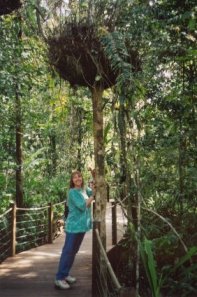 The trees in the rainforest are very strange. They
have adapted to their environment in lots of different ways but they are all trying to do
the same thing. They want to reach up and find sunlight. Some of the plants grow long thin
rope-like branches that grab onto other trees and help pull them up to the light. Other
plants like the one on the left have seeds that are blown around by the wind and hitch a
ride half way up other trees. This one is called a basket fern. Amy is holding us on the
tree trunk. It has big brown leaves at the bottom that catch dirt and dying leaves that
forms the soil they need to grow. They have adapted to their environment in the rainforest
by being able to grow half way up a tree and therefore have a better chance of getting
some sunlight.
The trees in the rainforest are very strange. They
have adapted to their environment in lots of different ways but they are all trying to do
the same thing. They want to reach up and find sunlight. Some of the plants grow long thin
rope-like branches that grab onto other trees and help pull them up to the light. Other
plants like the one on the left have seeds that are blown around by the wind and hitch a
ride half way up other trees. This one is called a basket fern. Amy is holding us on the
tree trunk. It has big brown leaves at the bottom that catch dirt and dying leaves that
forms the soil they need to grow. They have adapted to their environment in the rainforest
by being able to grow half way up a tree and therefore have a better chance of getting
some sunlight.
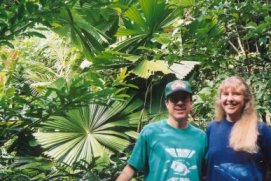 The fan palm on the right has leaves that go all the
way around in a circle. That gives it more surface area to catch the sunshine.
The fan palm on the right has leaves that go all the
way around in a circle. That gives it more surface area to catch the sunshine.
After we all walked around the town of Kuranda,
we rode the train back down the mountain.
There were some beautiful views!
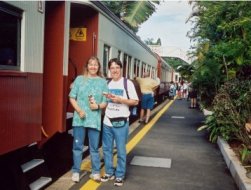 |
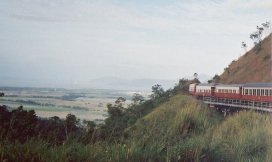 |
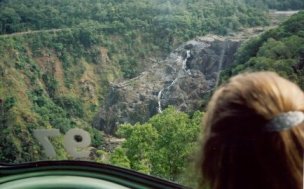 |
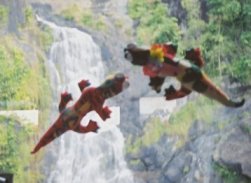 |
 Bob, Kini,
and Kimi stood on the street corner that use to be the Australian Barbary Coast in the
olden days. The tall sailing ships use to dock here and all the sailors would take their
shore leave on this strip of land. It was a very rough place with a lot of bars and
fights. It doesn't look like it now though. The name "Barbary Coast"
evidentially started in Africa but came to be a generally applied term for any dock that
had pirates and lawlessness. Bob, Kini,
and Kimi stood on the street corner that use to be the Australian Barbary Coast in the
olden days. The tall sailing ships use to dock here and all the sailors would take their
shore leave on this strip of land. It was a very rough place with a lot of bars and
fights. It doesn't look like it now though. The name "Barbary Coast"
evidentially started in Africa but came to be a generally applied term for any dock that
had pirates and lawlessness. The other thing we like about this picture is that if you look closely at the white van, it is driving on the wrong side of the road! Actually, in Australia, all the cars drive on the other side of the road. It makes it kind of tricky to cross the streets - we Americans have to look around for a long time to make sure there are no cars coming.
|
|
 We also had
to figure out how much U.S. money was worth. Tis picture shows that one Australian dollar
is worth about .58 United States dollars (or 58 cents). Bob told Kimi and me that the
easiest way to figure out what things cost in U.S. dollars was to round the figures. He
said that if something cost $10 dollars Australian, it would be a bit more than $5 dollars
U.S. In the picture with the cereals, the price reads $2.46. We had to remind ourselves
that the price was in Australian dollars. Kimi rounded the price to $2.50 and then figured
out what half of that was. She found out that one box would cost about $1.25 U.S. If you
would like to see how our money compares to other countries go to
http://www.forwardproductions.com/ucc.html. We also had
to figure out how much U.S. money was worth. Tis picture shows that one Australian dollar
is worth about .58 United States dollars (or 58 cents). Bob told Kimi and me that the
easiest way to figure out what things cost in U.S. dollars was to round the figures. He
said that if something cost $10 dollars Australian, it would be a bit more than $5 dollars
U.S. In the picture with the cereals, the price reads $2.46. We had to remind ourselves
that the price was in Australian dollars. Kimi rounded the price to $2.50 and then figured
out what half of that was. She found out that one box would cost about $1.25 U.S. If you
would like to see how our money compares to other countries go to
http://www.forwardproductions.com/ucc.html.
|
Headed Toward the Bush / Split Rock / Termite Mounds
On Monday we repacked all our clothes and scuba gear so that we could travel light. We were about to go on a trip to the bush and the outback for 4 days. Trudi helped us store our big bags at the hotel and when the 4-wheel jeep came to pick us up we had only two backpacks to carry. Ross Brown was our guide and there would be four other people coming along with us. From left to right, their names were Ross, Bob, Amy (with us - Kini and Kimi), Ute, Bob (yes, another one), Cecily, and Mary. Bob didn't know that Ross was giving him rabbit ears until we got home from the trip and developed the film. But if you look closely, Kimi was looking at Ross - she saw him do it and started to giggle. Even though this was one of the last photos we took, Kimi knew right off that this was going to be a great trip and Ross was going to be a great guide. We all liked each other right away.

Our adventure started at the Split Rock gallery. A gallery is an area where the aboriginal people painted pictures on the rocks or carved pictures into the rock that can date back to 40,000 years. Not all of them are that old and many of them are painted over the top of each other as the years rolled by. All of them are beautiful and tell us about the people who lived in the area so long ago. Sometimes we have to make a lot of guesses about what the ancients were trying to tell us through their paintings, but many times they also leave artifacts (the tools and articles they used in everyday life) that help us to understand them and their way of life.
|
|
Split Rock is located on the road north from Cairns and is very easy for the tourists and other people to access. It is a very nice site to start at. The big critter in a dark red color on the left hand side is called an Echidna or a spiny anteater. It is a bit hard to read its name on the plack Kini and Kimi are sitting by. The Echidna has very soft and delecate meat. Usually only the elder men, the leaders, would get to eat the spiny anteater because they usually didn't have the teeth to chew the tougher meats.
As we got further into the bush, we started to see termite mounds. At first they we very small, but then they started to get bigger and bigger. And then we started to see them change shapes. Ross told us that the mounds we were seeing above ground were only one third of what was there was underground! Evidently, the termites dig their tunnels underground and bring the extra dirt up to the surface at night. Then they use their spit to cement the dirt together to make the mounds we can see. They also use these mounds like a solar powered air-conditioning unit. The sun heats up the mound which heats up the air inside of it. Since hot air rises, tiny holes in the surface mound let the hot air out and brings cool air in from underground! The first picture is of a regular termite mound, the next is of a castle type of mound. Magnetic termites build their mounds so that they are very thin and stretch from north to south to catch the most sunlight and heat.
|
|
The Homestead / Jowalbinna Bush Camp
After about 7 hours of driving (mostly on bumpy dirt roads) we arrived at the Homestead. It is the home of Steven Trezise. Steven's father, Peircy, was the person who found most of the aboriginal galleries in this area by flying an airplane over the rock escarpments where he was actually able to see the paintings. He was responsible for a lot of the archaeological interpretations. Before we left,we had our picture taken with Steven!
|
|
|
We finally reached the bush camp at Jowalbinna and Ross jumped up to the top of the Jeep to get our bags down for us. It was a long and dusty drive. We checked out our sleeping quarters - a very nice tent (they called it a swag) and grabbed a towel to take a shower. |
|
The shower had a bathroom on either side of it. Water from the stream was pumped into a holding tank which then was piped into a barrel next to the shower. When you wanted a hot shower, you started a fire under the barrel and waited a while. When the water got hot it would expand, forcing it up the pipe to the shower and drawing the cold water in through the pipe at the bottom. They called this water heater a "donkey".
|
After our shower, Kimi and I took a stroll over to the food area. We look really tiny in the picture on the left. We met Heather the cook for the camp. She cooked up great food! See the bar at the top of her picture? It is one of a few lights in the camp.
|
The sky was never so bright and the silence never so deep as when we were in the Jowalbinna Bush Camp. However, it was a long way to the bathrooms in the middle of the night - but Bob and Amy were there with their "torch" (flashlight) to walk us out and back. We got to see the Southern Cross for the first time. It is only visible from the southern hemisphere - and it was beautiful! We also saw the Big Dipper. We can see that constellation from home but in Australia it is upside down!!
The Track / 3 Deaf Adders & Flying Foxes Galleries
In the morning, we saw a group of wallabies (called a mob), ate breakfast, then we started our hike to the Western escarpment and the Bradley Curcuit Galleries. We saw a dingo on the way out.
The "track" (road) was very bumpy but it was a lot of fun to drive on. We got out of the Jeep at the bottom of the escarpment and started our treck up to the bluffs. The first gallery we stopped at was the 3 Deaf Adders Gallery. You can see Ross in the white hat in front of the adder snakes with a fat whiskery catfish above them. There were many other paintings there along with a big Echidna and a bunch of ancient aboriginal spearmen.
|
The pictures below are of the flying foxes gallery. A flying fox is really a fruit bat that does not use radar to hunt, but uses its eyes instead.
|
|
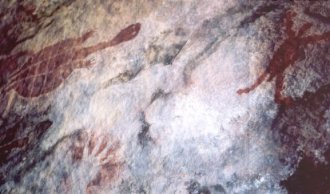 These
pictures are from the honeymoon gallery. The top one shows a long necked turtle, a hand
print, and a Quinkin. The red colored paint is made by mixing a ground up rock called
Ocher with water. To make a hand print, the person put some of this mixture into his mouth
and sprayed it over his hand. The hand prints tell us that most of the aborigines were
probably right-handed. The Quinkin is a guardian spirit. Some of them are good and some
are bad. This one is a good Quinkin because his arms are straight out. These
pictures are from the honeymoon gallery. The top one shows a long necked turtle, a hand
print, and a Quinkin. The red colored paint is made by mixing a ground up rock called
Ocher with water. To make a hand print, the person put some of this mixture into his mouth
and sprayed it over his hand. The hand prints tell us that most of the aborigines were
probably right-handed. The Quinkin is a guardian spirit. Some of them are good and some
are bad. This one is a good Quinkin because his arms are straight out.
|
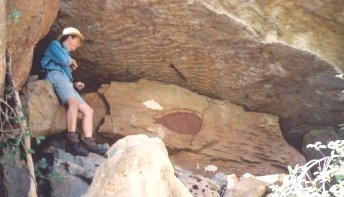  The two pictures above are of the Garfish Galley. Kimi and I thought that the name was sort of funny since the most visible painting is on the left and it is a catfish. The picture on the right is of the two garfishes with white outlines, people and spirits, hands, and other animals. |
Bob, Amy, Kimi, and I were very impressed with the Red Lady Gallery. As you can see in the first photo, there is a large painting of a red lady on the first wall of the gallery. She was thought to be the guardian spirit of this area. In the second photo, Amy is holding me, Kini, while Bob is standing beside the Red Lady and Amy is next to a huge wallaby. A wallaby is a small kangaroo. You can tell them apart in the paintings because wallabies have short front legs with a straight tail. Dingo paintings look a lot like wallabies, but dingos usually have equal legs and a tail that points straight up.
|
There were more pictures in the gallery but the photos will never show you how great to was to be there! |
Ross was true to his word. After we hiked down the
Western Escarpment, we took a bit of a detour and found a "billabong" (swimming
hole) to hop into while Ross put "the billy to boil" (made tea). He even took
the hot pot and swung it in 3 big circles by his side to "put the final touch on the
tea". Oh yea... we lizards and humans all jumped back!! But it was a wonderful cup
and not a drop spilled! Yahoo, Ross! The trail back was beautiful. The long grasses of the bush tickled our legs and the terrain was nice and flat. We were headed back to camp for lunch - and we were all very hungry! If you look closely at the backpack Bob is carrying, you will see some white spots. Those are Kimi's and my eyes! We have short little legs and asked Bob to give us a lift. Now, that was fun!
|
|
|
| Our second hike was a bit easier than
the first. We saw a big black slab of rock that had an area that been carved and chiseled
into the form of a woman. It was close to life-sized! These are the oldest markings left
by the aboriginal people. Before they used paints, they carved out pictures in the rocks.
Some sites have been carbon-dated (by using the remains of fires and trash) to 40,000
years ago! And we were standing here amongst the ancients! The picture of the hands is kind of unique. It shows only children's' hands! Kimi was very impressed. She loves children. It is hard to tell it in the photo, but these hands were tiny! |
|
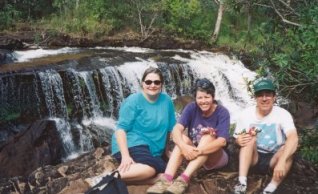  After a good night's sleep and an early 6:30am wake-up call by the Kookaburras (Australia's bird that laughs), we all packed up and hit the bumpy trail on our way to Cooktown. Ute, Cecily, Bob, Kimi, and I had our picture taken by a waterfall that literally poured over the road. At Cooktown we had our picture taken on Grassy Hill overlooking the river Captain Cook navigated. Then we found the statue of Captain Cook himself and wanted a picture of the four of us. Kimi and I decided to sit on the stone base. We are so small that we are kind of hard to see. Unfortunately, nobody was around to take it. So, Amy said that we could take two pictures and merge them together on the computer when we got home. Not bad Amy!! When Bob saw the lighthouse he had to take a photo for Lee, his dad. Lee loves lighthouses and this one was beautiful!
|
Black Mountain is a disintegrating mountain. A sign in front of it basically says that about 250 million years ago a mountain of molten rock (magma) hardened below the Earth's surface. It formed a HUGE mass of blackish granite rock.
Kini and Kimi were surprised to see that the animals that live on this mountain have made some unusual adaptations. There is a frog that lays its eggs on land rather than water, and hatches baby froglets rather than tadpoles. Two kinds of lizards are only found in this region. K & K loved reading about their cousins that live in a very different land!! |
After another wonderful and dusty day on the trails, Ross drove us into a tiny slice of heaven. The Mungumby Lodge was run by Keith and Judy Hopkins and an outstanding crew of employees. Dave was one of them. He met us as we drove up. By the time Dave showed us our cabins, we grabbed a cold beer, and had taken a shower, Dave and and the rest of the employees were serving us a tasty chicken and multiple kinds of yummy vegetables. Much to our surprise, Keith bought us a bottle of the best red wine we had tasted on the track. Lizards don't drink - but Bob and Amy, and the rest of our group loved it! Thank you Keith! After dinner we relaxed, got our pictures taken, and Bob and Amy stayed up late telling and listening to tales with Ross and Keith.
|
 We
stopped at a the Wujal Wujal waterfalls for a snack. Australians love their tea and
snacks! Wujal means water. When you have Wujal two times, that means BIG waters. These
were great waterfalls and they had a lot of water even in the dry season! There was a lot
of shade on the path to the falls which made it hard to take a photograph. We
stopped at a the Wujal Wujal waterfalls for a snack. Australians love their tea and
snacks! Wujal means water. When you have Wujal two times, that means BIG waters. These
were great waterfalls and they had a lot of water even in the dry season! There was a lot
of shade on the path to the falls which made it hard to take a photograph. |
 Sometimes,
in Australia, the beaches have what they call "marine stingers". By looking at
the sign, can you tell what kind of sea creatures these are? Kini is on the sign and he
says they are jellyfish. The sign says that "marine stingers" are in water
during the summer. Kimi is on the holder for a jug of vinegar. It says that you
should use it for marine stings. You should pour it on, not rub it in, then you should get
medical attention. Many of Australia's beaches have netting to keep the jellyfish out
during their summer season (our winter months). Sometimes,
in Australia, the beaches have what they call "marine stingers". By looking at
the sign, can you tell what kind of sea creatures these are? Kini is on the sign and he
says they are jellyfish. The sign says that "marine stingers" are in water
during the summer. Kimi is on the holder for a jug of vinegar. It says that you
should use it for marine stings. You should pour it on, not rub it in, then you should get
medical attention. Many of Australia's beaches have netting to keep the jellyfish out
during their summer season (our winter months).
|
Later we drove down the coast on our way back to Cairns. We took a break at the Mossman River Gorge. We were in the rainforest again and got to walk across a swinging bridge on the path. Be assured that Bob and Amy were jumping up and down to scare the rest of us. It worked! Kimi and I we hanging on tight (I think some others were too). |
| Yes ... we had to begin and end with this photo.
Thank you for all the good times, the good chats, the depth of the stars, and the
silence of the bush. Ross told us one night, that when you are in the camp or in the bush, you need to think differently - there is a timelessness about the world. I guess it boils down to having no phones, no radios, and only one to three hours to the nearest box of Band-Aids.
|
 |
|
When Bob and Amy developed their film, the last photo on the roll was "picture perfect". Kimi and I took one look at this photo Ross took and couldn't believe it. Bob and Amy will celebrate their 18th wedding anniversary the day after we get home. Kimi and I are proud to be a part of their lives and travels. They (and we lizards) can't stop talking about the people and friends that we met in on this part of our trip to "the land down under". |
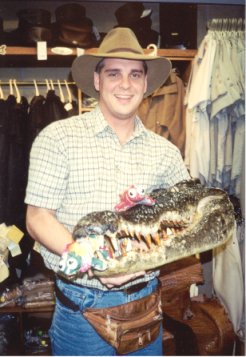 We had one day left in Cairns. We spent it shopping and had a lot of fun. Amy just had to have a long-length oilcloth coat - she had been trying it on since we arrived. Today she finally got it at the Aussie Bush Hats & Oilskins shop. But, before she bought it, Kimi and I were treated to how it would feel to be a treat for a crocodile! Now, that was scary!! Then we climbed into some oilskin insulated wine coolers. Amy took a photo of us but it was a really bad photo. Never the less, if we need a good sleeping bag, we have found the perfect ones! |
|
| We had a two hour flight to Sydney then a 5 hour (!) layover before boarding the plane (14 hours!) to Los Angeles. Bob found that we could ride the metro-rail train to Circular Quay and see the Oprah House and be back in the airport in time to catch our plane. Off we went!! The first thing we all saw was a bridge that the tourists could walk on - not just on the car level, but up and over the structure! The second picture is a close up of the loads of people walking to the top of the bridge. |
|
| Here we are at one of the most famous sites in the world! The Oprah House in Sydney! YIPPEE! Okay, so it was a quick walk around - but we were here! Yahoo! It is as beautiful as everyone has said. |
|
| Yes, Kini and Kimi saw this "MetalMan" and had to climb him. Then the unimaginable happened .... it moved!!! Yes, this was a real person standing on the street corner, holding very still till someone put a coin in his bucket. As soon as Bob put a coin in, MetalMan handed Kini and Kimi back and gave them each a lollypop! As we headed back to the train, K & K took a last look at the Sydney skyline and harbor. It was a beautiful day and because we would be flying toward the East, it would stay daylight for most of our trip home. |
|
| Mom picked us up after we had traveled for 36 hours. We were
very glad to be home. We started unpacking our new Australian toys and had to go play with
them. Bob and Mom liked the bullroarer. It is a thin, specially shaped piece of wood witha
string attached to one end. When you whirl it, it makes a deep humming sound. We haven't
gotten the courage to throw the boomerang yet - yes ... we are afraid that it will come
back - right between our eyes. We need to find a big sturdy tree to stand behind! We bought a didgeridoo too. A "didg" is a long skinny tree trunk that has been hollowed out by termites. The aboriginal people paint designs on them and then play them by blowing into to beeswax mouth piece. They make a very deep strange sound. To get more information or to hear what they sound like, surf the Australian Aboriginal Music Site (http://aboriginalart.com.au/didgeridoo/default.htm.) Bob, Amy, Kimi, and I had a wonderful time on our trip. If you
ever get a chance to go Australia - DO! For more information about the people who helped
arrange our trip, check out the following sites: |